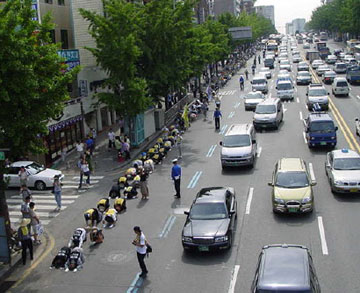
Nial Moores, Birds Korea, 2003.
The distance from Namdaemun to the Blue House is about five minutes by car. But if you travel the distance by taking three steps and then kowtowing on the road, it would take more than five hours. The trip from Buan in North Jeolla province to the Seoul city hall is about four hours by car, but doing the “three-steps-and-a-bow,” it would take about 60 days. The differences between driving and the more arduous journey are speed or slowness, efficiency or meditation, progress or peace.
In Buddhism, bowing is the greatest show of respect a person can make to the Buddha or the teacher. It lowers yourself to the lowest level, literally, by putting your head, knees and elbows on the ground while elevating the object of the bow. The bow in Buddhism differs according to the culture where the religion has spread. In Tibet, it is done with hands and feet spread and body flat on the ground. In Thailand and Vietnam, one bows his head three times while on one's knees.
The tradition of sam-bo, or “three steps,” is rooted in the idea of “three poisons.” Buddhist teaching has it that unless a person is able to shed the three poisons of greed, anger and foolishness there is no use in practicing the religion no matter how hard that person tries. So the custom of taking three steps came to signify the shedding of the three poisons.
The Jogye Order in Korea adopted the sambo ilbae, or three steps and a bow, in its curriculum designed for those who hoped to become monks. It was often the pain involved in this ritual that made would-be monks give up.
The Venerable Sugyeong of the Sudeoksa temple in South Chungcheong province first linked the practice with environmentalism, and samboilbae became the signature protest against the plan to drill a tunnel through Mount Bukhan and build a reservoir in Mount Jiri.
The Saemangeum Reclamation Project, started in 1991, is threatening one of the most important wetlands in Korea and the Yellow Sea Ecoregion. When four religious leaders, Father Mun Gyu-Hyun, Buddhist Monk Su-Kyong, Won-Buddhist Monk Kim Gyung-Il and Reverend Lee Hee-Un found out that countless living creatures in the Saemangeum tidal flat would be killed by the closure of the 33km long sea wall, they decided to devote themselves to those creatures.
They led a "samboilbae" from Saemangeum to the capital city, Seoul. For the entire distance of more than 320km (about 200 miles), they took three steps and then dropped to their knees and bowed down to the ground, then got up and took another three steps and a bow. Three steps mean one's own greed, anger and foolishness and one bow means sincere penitence for those three.
It took 65 days in cold rain and burning sun.
The religious marchers said, "We are practicing Samboilbae with the most sincere and bold spirits. Along the way, there will be pain and hardships. However, we will save the Saemangeum tidal flat, in order to persuade the world to expiate its sins and save life and peace."
At the end of the march, more than 8,000 people joined the religious leaders in Seoul: their determination and devotion to life and peace touched every Korean, and resulted in a majority of the Korean public becoming concerned for the Saemangeum tidal flat for the very first time.



